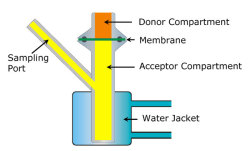Dermal uptake of arsenic has been underestimated up to now based on low permeability of arsenate. A new study finds that uptake of arsenic as arsenite or dimethylarsinic acid is a factor of 29 and 59 higher than that of arsenate.
Background:Inorganic arsenic is a confirmed human carcinogen causing skin and bladder cancer. The most common route of exposure is via ingestion of contaminated drinking water (see: our
News about contaminated drinking water). Due to the reported low permeability of arsenate dermal absorption of arsenic has been considered to be a minor exposure route and has so far not been studied in greater detail.
The new study:
Fig.: Franz diffusion chamber
|
Researchers from the University of Aberdeen now had a closer look on the effect of different arsenic species on their uptake through the human skin. They used human skin (obtained from cosmetic surgical intervention) in a so called Franz Cell for permeation studies. Different arsenic compounds, such as arsenate, arsenite, dimethylarsinic acid (DMA(V)) and a seaweed extract containing mainly arsenosugars were used as model substances.
Total arsenic in the skin was determined by ICP-MS after microwave-assisted digestion and its spatial distribution was determined by laser ablation coupled to ICP-MS detection. Arsenic speciation analysis was performed via HPLC coupled with ICP-MS or ESI-MS detection.
The observed penetration rates of the different arsenicals were more than one order of magnitude different. Arsenite and DMA(V) exhibit 29 or 59 times faster dermal penetration in comparison to arsenate and the arsenosugars, respectively. Interestingly, no significant species transformation were observed during uptake and permeation. Also the concentration of arsenic within the epidermis was about a factor of 10 higher for arsenate and arsenite than for the organic arsenic species.
The authors conclude that exposure of farmers resulting from standing in the contaminated water of paddy rice fields might have been grossly underestimated. Such dermal exposure could therefore be the reason for the Blackfoot disease observed in Taiwan.
 The original study
The original study
Sairoong Ouypornkochagorn,
Jörg Feldmann,
Dermal Uptake of Arsenic through Human Skin Depends Strongly on Its Speciation, Environ. Sci. Technol. 44 (2010) 3972–3978.
DOI: 10.1021/es903667y Related studies
Related studies (newest first)

Y.W. Lowney, R.C. Wester, R.A. Schoof, C. A. Cushing, M. Edwards, M.V. Ruby,
Dermal absorption of arsenic from soils as measured in the rhesus monkey, Toxicol. Sci., 100 (2007) 381–392.
DOI: 10.1093/toxsci/kfm175
R.C. Wester, X. Hui, S. Barbadillo, H.I. Maibach, Y.W. Lowney, R.A. Schoof,
In vivo percutaneous absorption of arsenic from water and CCA-treated wood residue, Toxicol. Sci., 79 (2004) 287–295.
DOI: 10.1093/toxsci.kjh114
R.H. Guy, J.J. Hostynek, R.S. Hinz, C.R. Lorence,
Metals and the Skin - Topical Effects and Systemic Absorption, Marcel Dekker, New York, 1999

M.F. Hughes, C.T. Mitchell, B.C. Edwards, M.S. Rahman,
In-vitro percutaneous absorption of dimethylarsinic acid in mice, J. Toxicol. Environ. Health, 45 (1995) 279– 290.
DOI: 10.1080/15287399509531996
M.S. Rahman, L.L. Hall, M.F. Hughes,
In vitro percutaneous absorption of sodium arsenate in B6C3F1 Mice, Toxicol. in Vitro., 8 (1994) 441– 448.
DOI: 10.1016/0887-2333(94)90166-X
R.C. Wester, H.I. Maibach, L. Desik, J. Melendres, M. Wade,
In vivo and in vitro percutaneous
absorption and skin decontamination of arsenic from water and soil, Fundam. Appl. Toxicol.,
20 (1993) 336–
340.
DOI: 10.1016/faat.1993.1043 Related Information
Related Information
 Related EVISA Resources
Related EVISA Resources Brief summary: LC-ICP-MS: The most often used hyphenated system for speciation
analysis
Brief summary: LC-ICP-MS: The most often used hyphenated system for speciation
analysis Brief summary: ESI-MS: The tool for the identification of chemical species
Brief summary: ESI-MS: The tool for the identification of chemical species Link database: Toxicity of arsenic species
Link database: Toxicity of arsenic species Related EVISA News
Related EVISA News
 February 23, 2009: Toenail clippings reveal arsenic exposure
February 23, 2009: Toenail clippings reveal arsenic exposure  January 17, 2007: Human metabolism of arsenic is altered by fasting
January 17, 2007: Human metabolism of arsenic is altered by fasting last time modified: May 20, 2024